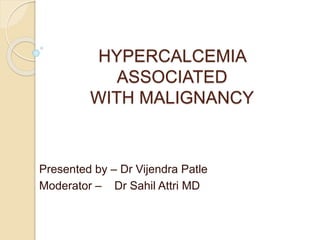Hypercalcemia is a common metabolic complication in cancer patients, linked with a poor prognosis and often caused by factors like parathyroid hormone-related peptide (PTHrP), cytokine production, and excess vitamin D. Clinical manifestations vary from mild symptoms like fatigue to severe complications requiring urgent management, including hydration and bisphosphonates for treatment. The document details the mechanisms, diagnosis, and treatments for hypercalcemia associated with malignancy, emphasizing the need for addressing the underlying cancer.









![Calcium homeostasis is regulated
by following hormones-
parathyroid hormone (PTH)
1,25-dihydroxy vitamin D (1,25[OH]2D)
Calcitonin
serum calcium
serum phosphorus](https://image.slidesharecdn.com/hypercalcemiaassociated-230117174343-eba94741/85/HYPERCALCEMIA-ASSOCIATED-WITH-MALIGNANCY-pptm-2-pptx-10-320.jpg)
![Mechanism of Hypercalcemia
by Paratharmone-
PTH is produced by the parathyroid glands. It
increases serum calcium and decreases serum
phosphorus via direct and indirect stimuli of
osteoclasts. It increases renal calcium absorption and
decreases renal phosphorus absorption.
PTH also stimulates the conversion of 25-hydroxy
vitamin D (25[OH]D) to1,25(OH)2D in the kidneys
through 1-a-hydroxylase, which results in increased
intestinal absorption of both calcium and phosphate.](https://image.slidesharecdn.com/hypercalcemiaassociated-230117174343-eba94741/85/HYPERCALCEMIA-ASSOCIATED-WITH-MALIGNANCY-pptm-2-pptx-11-320.jpg)

![There have been several proposed
mechanisms for hypercalcemia associated
with malignancies which mainly include:
1. Humoral hypercalcemia of malignancy
2. local osteolytic hypercalcemia
3. excess extrarenal activated vitamin D (1,25[OH]2D)
4. PTH secretion- ectopic or primary](https://image.slidesharecdn.com/hypercalcemiaassociated-230117174343-eba94741/85/HYPERCALCEMIA-ASSOCIATED-WITH-MALIGNANCY-pptm-2-pptx-13-320.jpg)





![Extra renal production of
1,25(OH)2D
Extra renal production of 1,25(OH)2D by the tumor
accounts for approximately 1% of cases of
hypercalcemia in malignancy.
In normal vitamin D metabolism, stored vitamin D
(25[OH]D) in the liver is converted to 1,25(OH)2D
under the influence of PTH by renal 1-a-hydroxylase
in the kidneys.
1,25(OH)2D causes - increased intestinal absorption
of calcium and enhances osteolytic bone resorption,
resulting in increased serum calcium.](https://image.slidesharecdn.com/hypercalcemiaassociated-230117174343-eba94741/85/HYPERCALCEMIA-ASSOCIATED-WITH-MALIGNANCY-pptm-2-pptx-19-320.jpg)



























